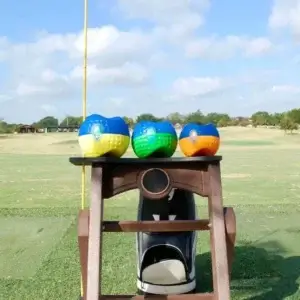
Are You Making These 5 Common Putting Mistakes?
The importance of putting in a standard game of golf is drilled into players’ minds from the first moment they pick up a club. It’s estimated that putting accounts for over 40% of the strokes during a standard round of golf, with occasional fluctuations depending on player handicap and how you are playing on the day.
However, it’s fair to say that the amount of putts you take per round is key in influencing your final score at the end of your golf game. The reality is for many amateur golf players or those who consider it a hobby, inconsistent putting leads to those frustrating 3-putts and missed opportunities to lower scores.
With the average golfer needing between 31 and 34 putts per round to be considered a ‘good putting game’, cleaning up errors on the greens presents the most impactful way to shave strokes off your handicap. By identifying and correcting the most frequent putting mistakes, you can transform from a shaky putter into a confident drainer of clutch putts in good time, aided drastically by constant practice on a golf course as well as investing in a high-quality golf simulation system to refine your game.
In this article, we’ll break down the five biggest putting faults committed by amateur golfers and provide fixes to upgrade your skills on the greens. Read on to pinpoint areas for improvement in your current putting technique.
The Top 5 Putting Mistakes Among Amateur Golfers
1 – Faulty Setup and Alignment
Proper alignment and posture during setup is arguably the most critical step to refining your putting game. Misaligned feet, shoulders and eyes will send the ball wayward, even if your stroke mechanics are sound.
Here are the key steps for getting your setup spot-on:
- Place feet shoulder-width apart, perpendicular to the target line
- Position the ball off the instep of your leading foot
- Keep your eyes directly over the ball for straight back/through motion
- Align clubface square to target
- Avoid an open or closed face
- Set shoulders parallel to the target line
- Avoid hunched or slouched posture
Use ball lines and clubfaces to drill the ideal positioning into your practice sessions, and use the putting simulation exercises in a golf simulator to crunch the numbers and work your way upward. Ingraining proper alignment first will make your putting stroke more effective with time.
2 – Faulty Grip
Your grip directly controls the face angle and influences the pendulum-like motion of an effective putting stroke. A weak, unstable grip leads to mishits and uncontrollable distance and power, meaning putting becomes a game of chance rather than a strategic, methodical practice.
Use a light, neutral grip without tension or clenching and place the handle in the fingers of your lead hand, not the palm. Let the grip run through your trailing hand with minimal wrist action. Your index fingers should point down the target line for better directional control.
Experiment to find the ideal putter grip to enhance your stroke. Consistently rehearse your grip pressure and hand positioning and before long, you will start to see your putts become cleaner.
3 – Poor Stroke Path and Tempo
An unsteady back and through stroke path generates mishit putts that stray offline. Your swing path should trace a straight line along the target line.
Quite often, amateur players see their wrists flipping or loosening during takeaway and follow-through, which misaligns their hit. Or their shoulders will open, or their head will sway during the swing which can influence the direction of their hit. Moving laterally or rotationally will lessen the impact of your stroke path and disrupt your tempo.
Use straight-line putting guides to learn the ideal arced motion that holds the face square to the path. Control tempo and avoid rushed strokes to improve distance judgement.
4 – Incorrect Green Reading
Even tour pros spend ample time reading greens to account for slopes, grain and other environmental elements. Failing to properly read how a putt will break can lead to frustrating putting results.
Walk around the hole to gain perspectives on slopes and breaks and use the stakes or your putter to “plumb” the line of putts. Note the prevailing grain direction and speed of the greens for added accuracy. Visualise how path, pace and break will affect your putts on the green you are currently on.
Constant repetition and making mental notes while putting will hone your ability to read greens effectively. Don’t just look at the hole – pay attention to the best entry points.
5 – Lack of Pre-Shot Routine
Having a consistent pre-shot routine instills confidence and focus on the ball during those all-important putting strokes. However, most amateur golfers fail to establish effective putting rituals and can often approach each putt blindly.
Follow these brief steps to refine your pre-putt routine:
- Pick your line and visualise the speed required
- Take 1-2 practice strokes with your eyes on the hole
- Set your posture and grip to trigger muscle memory
- Keep your head and body steady over the ball
- Make a smooth, straight back and through stroke
Repeat the same checklist before every putt to make it habitual and before long, you will be able to execute the process more confidently.
How Golf Simulators Can Upgrade Your Putting Skills
Using a golf simulator provides the ideal practice environment to correct these putting pitfalls through simulated exercises, repetitions and tailored programmes to suit each player’s experience level. The sensors, feedback data and ability to simulate diverse putting scenarios allow you to measure and track improvement across all skill areas.
With golf simulator systems like those offered by Golf Swing Systems, you can refine your grip pressure and hand placement, improve your green-reading skills and repeat pre-shot routines to train your mind. Naturally, you’ll be able to get your setup and alignment on track through repeated exposure to your simulation software.
By practicing putting for 10-15 minutes each time you use the golf simulator software, without heading to the course, you can see drastic improvements before you play another round of 18. Breaking down putting fundamentals via simulator metrics will quickly lead to sinking more putts when it counts on the course.
Say Goodbye to Putting Woes
With consistency, data-driven improvement, and repetitively mastering putting fundamentals, you’ll gain the skills and confidence to avoid making those frustrating putting mistakes that affect players of all experience levels.
Contact Golf Swing Systems today to learn more about installing a high-tech golf simulator in your home for game-changing, meaningful practice.











